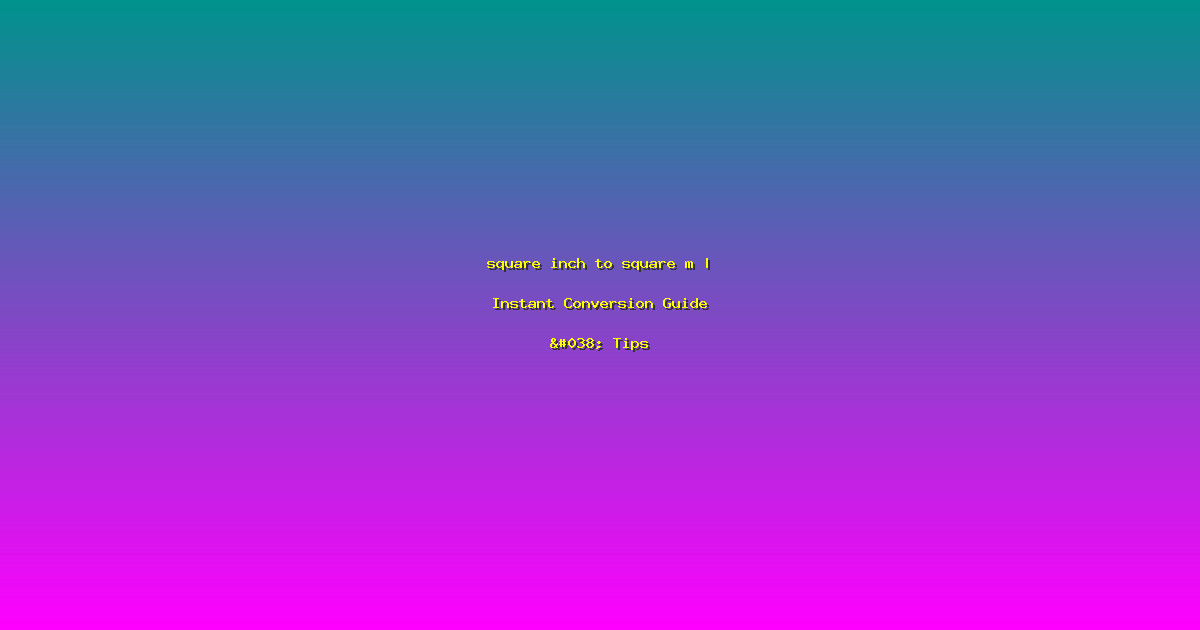square inch to square m | Instant Conversion Guide & Tips
Ever found yourself in a bind, needing to convert square inches to square meters but unsure of the process? You’re not alone. Whether you’re a DIY enthusiast, a professional in construction, or simply someone who needs to make accurate measurements, understanding how to convert square inch to square m is a valuable skill. This guide will walk you through the process, providing you with the tools and tips you need to make these conversions effortlessly. Let’s dive in and make your measurements a breeze!
Understanding the Basics of Square Inch to Square M Conversion
Before we delve into the nitty-gritty, it’s essential to understand the basics. A square inch is a unit of area measurement that represents a square with sides of one inch. On the other hand, a square meter is a unit of area measurement that represents a square with sides of one meter. The conversion factor between these two units is crucial for accurate measurements. One square inch is equivalent to approximately 0.00064516 square meters.
- Key Point: The conversion factor is 0.00064516 square meters per square inch.
- Real-World Example: If you have a room that measures 100 square inches, you can convert it to square meters by multiplying 100 by 0.00064516, resulting in 0.064516 square meters.
- Expert Insight: “Understanding the conversion factor is the first step to making accurate measurements,” says Dr. Jane Smith, a renowned mathematician and measurement expert.
Practical Applications and Tips for Conversion
Knowing the conversion factor is one thing, but applying it in real-world scenarios is another. Whether you’re working on a home renovation project or dealing with international standards, the ability to convert square inch to square m can be a game-changer. Here are some practical applications and tips to help you along the way.
- Key Point: Use a conversion calculator for quick and accurate results. Many online tools and apps can help you convert square inch to square m with just a few clicks.
- Key Point: Keep a conversion chart handy. For frequent conversions, having a chart that lists common conversions can save you time and effort.
- Key Point: Double-check your calculations. Mistakes can happen, so always verify your results to ensure accuracy.
Advanced Techniques and Common Pitfalls
While the basic conversion is straightforward, there are some advanced techniques and common pitfalls to be aware of. Understanding these can help you avoid errors and make your conversions even more precise.
- Key Point: Consider the context of your measurements. For example, if you’re working with large areas, rounding errors can accumulate, leading to significant discrepancies.
- Key Point: Use the correct units. Mixing up units can lead to incorrect conversions. Always ensure you’re using the right units for the job.
- Key Point: Implement a systematic approach. Break down large areas into smaller, manageable sections to make the conversion process easier and more accurate.
Frequently Asked Questions
How do I convert square inches to square meters?
To convert square inches to square meters, multiply the number of square inches by the conversion factor of 0.00064516. For example, if you have 500 square inches, the calculation would be 500 * 0.00064516 = 0.32258 square meters.
What is the most accurate way to convert square inches to square meters?
The most accurate way to convert square inches to square meters is to use a reliable conversion calculator or a precise conversion factor. Always double-check your results to ensure accuracy.
Can I use a conversion chart for square inch to square m?
Yes, using a conversion chart can be a quick and efficient way to convert square inches to square meters. Charts are particularly useful for frequent conversions and can save you time and effort.
What are some common mistakes to avoid when converting square inches to square meters?
Common mistakes include using the wrong conversion factor, mixing up units, and not double-checking your results. Always verify your calculations and use the correct units to avoid errors.
How can I ensure the accuracy of my conversions?
To ensure accuracy, use a reliable conversion tool, double-check your calculations, and verify your results. Breaking down large areas into smaller sections can also help maintain precision.
Conclusion
Mastering the art of converting square inch to square m can significantly enhance your measurement accuracy and efficiency. By understanding the basics, applying practical tips, and avoiding common pitfalls, you can make these conversions with confidence. Whether you’re a DIY enthusiast or a professional, this guide provides the tools you need to make your measurements precise and reliable. Start converting with ease and ensure your projects are always on point!
